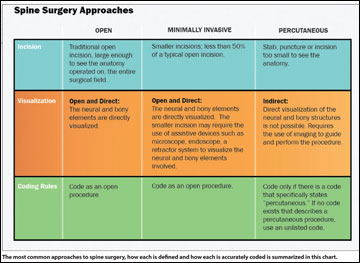Approach matters: How the type of spine surgery impacts code selection
Associate Editor, Neurosurgery

Kim Pollock

Teri Romano
The increase in less invasive spine procedures has resulted in some confusion, among surgeons and payers alike, regarding accurate coding and payment, for these nontraditional spine approaches. Approach does matter.
Codes are valued (and paid) based on the amount of physician work, both time and intensity. Different approaches — a small incision vs. a puncture vs. a conventional open incision — translate to different work effort and, therefore, different payment. The Figure summarizes the most common approaches to spine surgery, how each is defined and how each is accurately coded.
Most CPT codes for spine procedures are intended for traditional open procedures. Open procedures are those with incisions large enough to see the entire surgical field. If a CPT code does not specify an approach, the code is intended for an open procedure. For example, CPT code 63030 is used to report an open laminotomy performed with direct visualization in the lumbar region.
Percutaneous surgery description
In comparison, percutaneous procedures, which use a stab or puncture approach, visualize the anatomy only with the aid of an endoscope and/or fluoroscopy or other imaging. As stated in CPT Assistant July 2012, “If the visualization is performed via endoscope and/or image guidance, the procedure is considered to be percutaneous. When the instrument is used in any fashion without direct visualization of the neurologic structures by naked eye/microscope and/or loupe magnification, then it would be consistent with a percutaneous laminectomy. CPT codes are developed to best describe a surgical technique and not a specific device and/or instrument.”
Codes for percutaneous procedures will always have the term “percutaneous” in the code description. If the term percutaneous is included in a code description, that CPT code may not be used for an open procedure. Examples of codes intended for a percutaneous approach include percutaneous aspiration within the nucleus pulposus, intervertebral disc or paravertebral tissue for diagnostic purposes (62267), percutaneous vertebroplasty (22510-22512), and percutaneous laminotomy/laminectomy (interlaminar approach) for decompression of neural elements under direct image guidance (0274T). For some percutaneous procedures (for example 62267, aspiration of nucleus pulposus and, until 2015, vertebroplasty), imaging may be separately reported. However, since imaging is typically integral to a percutaneous procedure, newly developed percutaneous codes are more likely valued to include imaging.
Please click below to see Chart.
Open codes OK for MIS surgery
Minimally invasive procedures, more similar to open than percutaneous procedures, use a smaller incision than used for a traditional open procedure, but still allow for direct visualization of the pathology and the bony and neural elements involved. Minimally invasive procedures may utilize adjuncts to facilitate visualization, such as endoscopes or tubular retractor systems. Minimally invasive spine procedures, since visualization is open and direct, are coded with appropriate open spine codes and reimbursed the same as open codes. Examples include 63030, a discectomy using a tubular retractor system, or 22558, when performed as minimally invasive lateral interbody fusion. Even if a laminotomy (63030) is endoscopically assisted, the procedure is considered open if it requires open and direct visualization. (CPT Assistant July 2012).
Future articles in the Spine Coding Source column will focus on spine coding and documentation.
For more information:
Teri Romano RN, MBA, CPC, and Kim Pollock RN, MBA, CPC, are consultants with KarenZupko & Associates Inc. and serve as faculty members of the American Association of Neurological Surgeons national coding and reimbursement courses. For more information, visit www.karenzupko.com.Disclosures: Pollock and Romano have no relevant financial disclosures.

